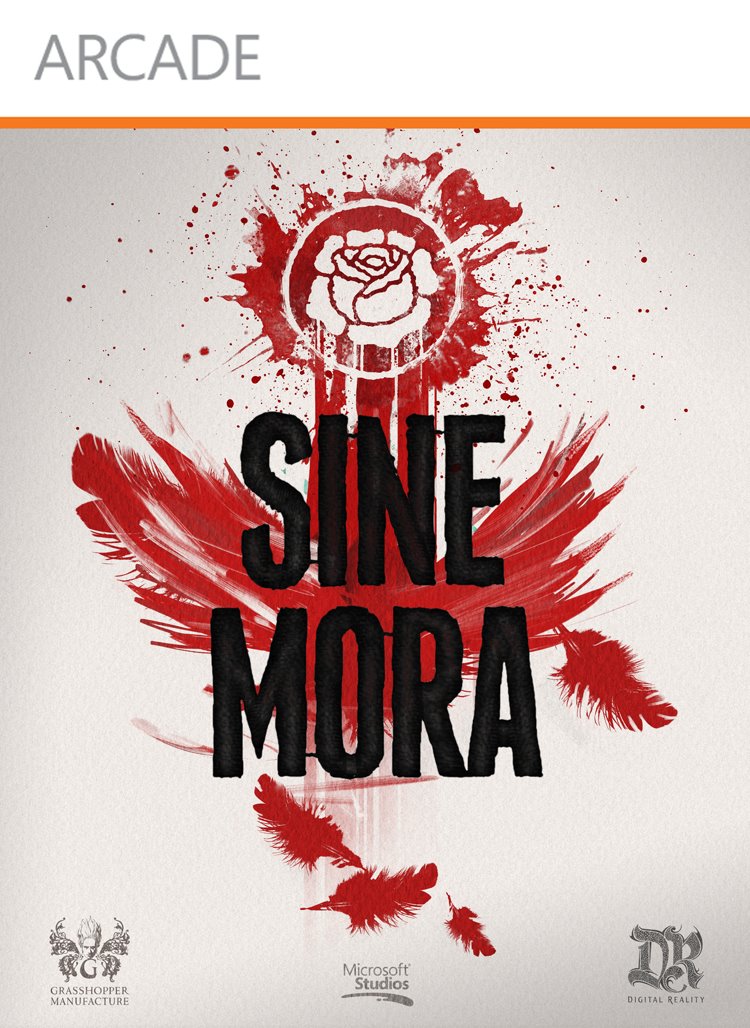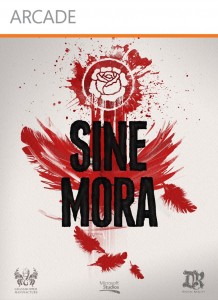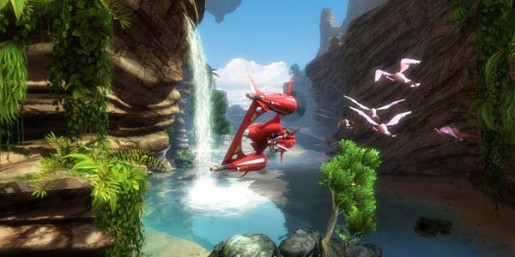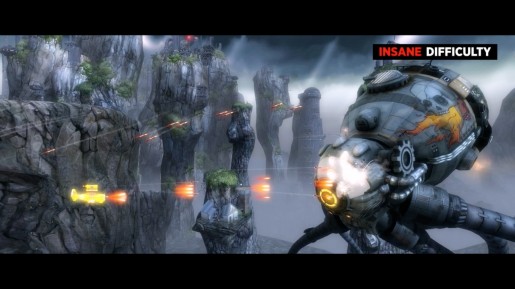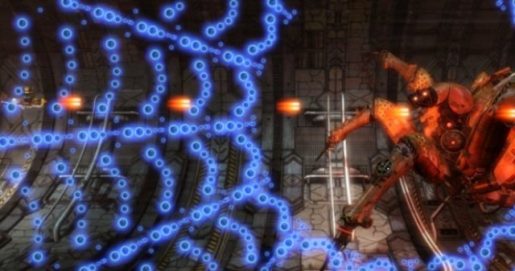Sine Mora is one of those games coming straight out of left field. In this instance, left field will be represented by Japan whereas the rest of the baseball field is America wondering why left field keeps giving them funny looks when they mention the upcoming Akira remake. One of left field’s greatest runningbacks and, no, I don’t play a lot of sports, is arguably right-wing defenseman quarterback Goichi Suda, or, as the industry calls him, Suda51. Head of Grasshopper Manufacture and the man responsible for some of gaming’s most insane offspring, Killer7 and No More Heroes, Suda51 has a strange pedigree behind him, but being a release between Shadows of the Damned and the upcoming Lollipop Chainsaw, Sine Mora seems to be a beast handled by a different set of extremely creative hands.
Digital Reality’s Theodore Reiker seems to be the creative father for this unique title. Working alongside Grasshopper, Digital reality is a developer known for games of a somewhat more intelligent nature. Sine Mora has an unbelievable amount of backing and creativity for a game as simple as a bullet hell shooter (also known as an STG) but can this unprecedented newcomer face up against old industry greats like 1942 or even more so, other artful bullet hells like Ikaruga? Check out the HOTs and NOTs of Sine Mora!
HOT
Masterful Tone
The moment one looks at the names of either developers, they may be inclined to immediately think complex tactics or dong jokes. They might be disappointed on both accounts. While the game does feel tactical and well balanced, and the game has its share of mature content, what the game does well is exactly its own thing. Games like Ikaruga and Guwange have attempted somber and intense tone in bullet hells before, but Sine Mora hits it out of the park – from left field. While the game has a pretty in-depth story that we’ll… touch on later, here I am talking about what the story does for the game and not the story itself.
During Story Mode, you’re taken through the game from beginning to end, switching pilots, planes, sub-weapons and time powers the entire time, but the game isn’t afraid to slow down for a second to show you what the character is thinking, why they are thinking it and why this fight, the one you’re playing through right now, is so important to them. The characters narrate as they move along and for long stretches in between levels. The narration is entirely in Hungarian, a language that seems to fit the game’s somber and contemplative tone to a perfect fit. If you’re looking to play a Bullet Hell for the sheer experience, Sine Mora provides better than all the rest.
Creative Mechanics
You do not have a life bar in Sine Mora. Let’s get one thing straight before I elaborate, you do not have a life bar in MOST bullet hells, a subgenre of games more than eager to watch you fail while shrieking in hideous, sadistic fits of laughter. But Sine Mora isn’t just life bar-less because it’s cruel and sadistic, though that’s certainly part of it. Instead, the player has a timer counting down to their demise. Every time you get hit, the timer goes down a brutal chunk of precious time. Every time you kill an enemy, your time is increased, usually less than one pitiful, absolutely necessary second. This works in keeping with the game’s themes, one of which being time travel, but it works as a revolutionary mechanic for bullet hells at the same time.
In an average bullet hell, dodging is absolutely key. All you can do is dodge outlandish amounts of bullets and just kind of assume your targets are hitting something and that, at some point during your dodging mayhem, whatever you’re shooting at will die. You do not have the luxury in Sine Mora. Since your timer is constantly falling, you will always have to make the split-second choice of whether you want to take the safe route to dodging bullets and enemies and sacrifice a couple dozen bullets up the enemy’s nose, or put yourself in harms way to land a few more shots while the timer, the tension building monster that it is, slowly ticks away and lord knows how much time you truly have left. It’s an interesting spin on the bullet hell shooters and if it became a staple of the series, that would be perfect.
Outstanding Presentation
A Shmup game has not been allowed safe critical passage without style ever since U.N. Squadron. Thankfully, style is exactly what Sine Mora’s got. From the designs of the anthropomorphic animal characters to Neon Genesis Evangelion’s character designer Mahiro Maeda’s extremely pretty artistic sensibilities, not a single sound or graphic in this game feels out of place or unnecessary. It’s all beautiful and stylized and the eye-candy never skips a beat. Going back to the topic of tone a few paragraphs back, every polygon works toward the goal of a bombastic but ultimately tragic atmosphere. It’s different and creative and maybe the greatest looking top-down shooter ever.
NOT
Incomprehensible Story
Sine Mora does indeed have a story, and the few glimpses that we see of it make the game a heavy and beautiful experience. The problem, however, is that all we can go off is what the characters are currently feeling. Only at the last levels do players finally get a fleshed out picture of what’s going on in Sine Mora, and even then the storytelling is so non-linear and is, simply, too short to carry out the massive plot that the game apparently has. A few more hours in Sine Mora’s world would have done the game miles of good, but as it stands, it’ll take multiple playthroughs to get a good idea of the inner workings of Sine Mora and by then, the last boss will have already come and gone. The climax, while awesome, simply could have been better with a clearer understanding.
Strange Difficulty Options
I am not complaining that Sine Mora is too hard. Apparently you’re not allowed to anyway, it’d be like complaining that Dark Souls was too punishing. Insane difficulty is what makes the games stand out. What is weird, however, is that the easy and medium modes are restricted to the Story campaign while the hard and perversely challenging modes are saved for the Arcade campaign. The idea was to stretch out the game’s length, so no matter what level player you are, when you finished the story, it was time to move on to Arcade mode.
This is a problem because it is a mechanic set in place to compromise all levels of players. Expert bullet hell players may want to enjoy the game’s story, but be forced through obnoxiously easy levels for their standards, while beginner players who want to play with Arcade mode’s array of interchangeable pilots, fighters and powers will be beat down by a difficulty curve they simply aren’t ready for. This is by no means a deal breaker, but it goes to show that cheap gameplay lengthening mechanics can cheapen the experience for any game, not just the already cheap ones.
VERDICT
 Sine Mora may simply be the best bullet hell ever. It’s a genre that hasn’t exactly had a chance in the spotlight as of late, unless you live in Japan, but even going up against the entire ocean of genre equals, with interesting gameplay twists, impeccable presentation and a tone that came from absolutely out of nowhere, it’s an experience that not even most mainstream games know how to come close to, and these are the reasons that the downloadable market exists. A high minded game using simplistic ideas and priced at only 15 dollars? That is a recipe for a higher standard of video game and it should be treated as such.
Sine Mora may simply be the best bullet hell ever. It’s a genre that hasn’t exactly had a chance in the spotlight as of late, unless you live in Japan, but even going up against the entire ocean of genre equals, with interesting gameplay twists, impeccable presentation and a tone that came from absolutely out of nowhere, it’s an experience that not even most mainstream games know how to come close to, and these are the reasons that the downloadable market exists. A high minded game using simplistic ideas and priced at only 15 dollars? That is a recipe for a higher standard of video game and it should be treated as such.

